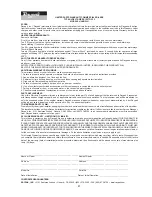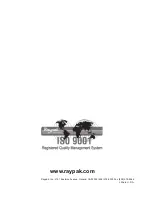
39
8. Turn on all electric power to the appliance.
9. Set thermostat to desired setting. The appliance
will operate. The igniter will glow after the pre-
purge time delay (15 seconds). After igniter
reaches temperature (45 seconds) the main valve
will open. System will try for ignition three (3)
times. If ignition is not sensed, lockout will com-
mence.
10. If the appliance will not operate, follow the instruc-
tion "To Turn Off Gas To Appliance", and call your
service technician or gas supplier.
11. Replace access panel.
To Turn Off Gas To Appliance
1. Set the thermostat to lowest setting.
2. Turn off all electric power to the appliance if serv-
ice is to be performed.
3. Remove upper front panel.
4. Turn off main manual gas valve.
5. Replace access panel.
If heater fails to start, check for:
•
Loose connections, blown fuse or service switch
off?
• High temperature limit switch set below heater
water temperature?
•
Thermostat set below room temperature?
•
Gas not turned on at meter or heater?
•
Incoming gas pressure less than 6 in. WC for nat-
ural gas, 11 in. WC for LP gas.
MAINTENANCE
Suggested Minimum
Maintenance Schedule:
Regular service by a qualified service agency and
maintenance must be performed to ensure maximum
heater operating efficiency. Maintenance as outlined
below may be performed by the owner.
Yearly (Beginning of each heating
season):
1. Annual service call by qualified service agency.
2. Visually check top of vent for soot. Call service
person to clean. Some sediment at bottom of vent
is normal.
3. Visually inspect venting system for proper func-
tion, deterioration or leakage.
4. Check that heater area is free from combustible
materials, gasoline, and other flammable vapors
and liquids.
5. Check for and remove any obstruction to the flow
of combustion or ventilation air to heater.
6. Follow pre-start-up check in the Initial Start-up
section.
7. Visually inspect burner flame. Should see light
blue flame. Visually inspect hot surface igniter for
damage, cracking or debris build-up.
8. Check operation of safety devices. Refer to manu-
facturer’s instructions.
9. Follow oil-lubricating instructions on circulator.
Over-oiling will damage circulator. Water-lubricat-
ed circulators do not need oiling.
10. To avoid potential of severe burn, DO NOT REST
HANDS ON OR GRASP PIPES. Use a light touch
- return piping will heat up quickly.
11. Check blower and blower motor. Clean and oil as
necessary.
12. Check for piping leaks around circulators, relief
valves and other fittings. Repair, if found. DO NOT
use petroleum based stop leak.
Daily:
1. Check that heater area is free from combustible
materials, gasoline, and other flammable vapors
and liquids.
2. Check for and remove any obstruction to the flow
of combustion or ventilation air to heater.
Summary of Contents for 122
Page 16: ...16 Fig 11 Single Heater Domestic Hot Water with One Storage Tank ...
Page 35: ...35 WIRING DIAGRAM MODELS 122 322 ...
Page 42: ...42 ...
Page 43: ...43 ...






































